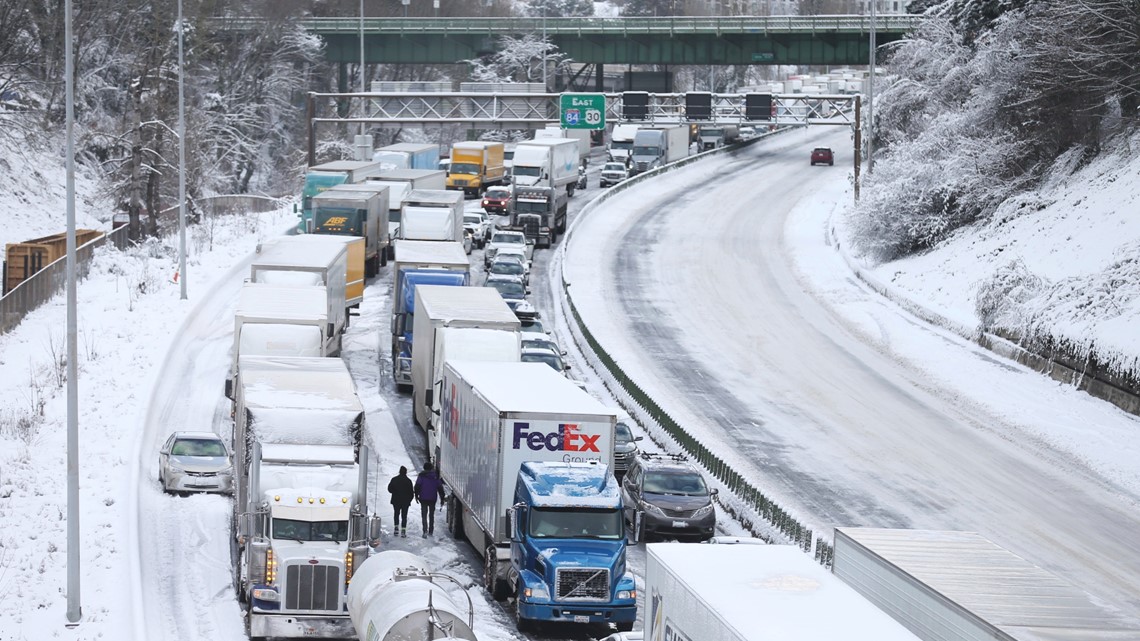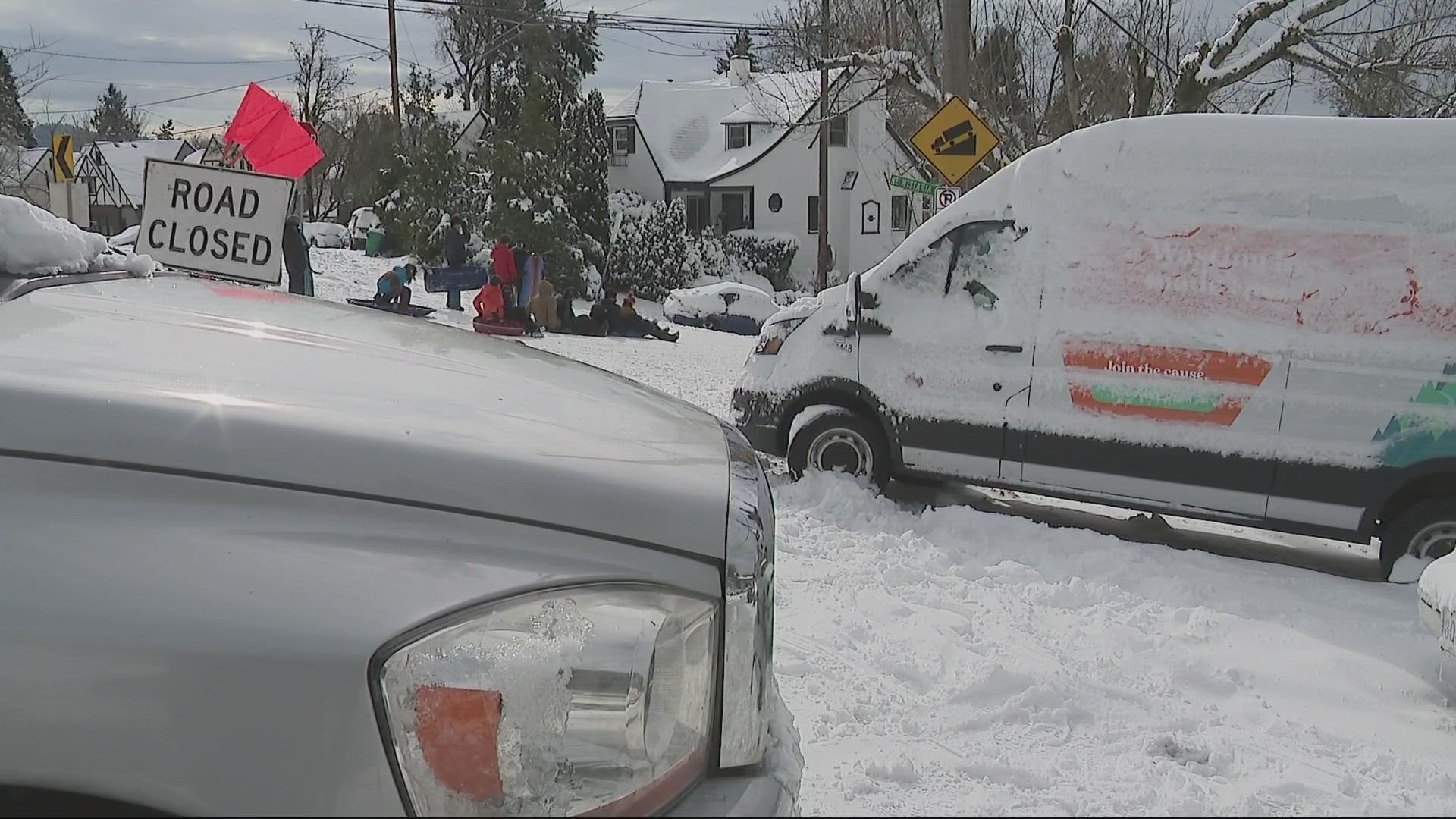PORTLAND, Ore. — Winter storms sowed more chaos across the U.S. on Thursday, shutting down much of Portland with almost a foot of snow and paralyzing travel from parts of the Pacific Coast all the way to the northern Plains.
The nearly 11 inches that fell in Portland amounted to the second snowiest day in the city's history. It took drivers by surprise, stalling traffic during the Wednesday evening rush hour and trapping motorists on freeways for hours. Some spent the night in their vehicles or abandoned them altogether as crews struggled to clear roads. Other commuters got off spun-out buses and walked in groups to safety.
The storms also knocked out power to almost a million homes in multiple states, closed schools and grounded or delayed thousands of flights.
Kim Upham endured a 13-hour ordeal as snow brought to a standstill the traffic on U.S. 26, a mountainous highway that connects Portland to the coast.


Already treacherous because of its steep grade, the highway was covered in a sheet of ice, forcing some drivers to leave their cars in the middle of the road.
“It was so scary to have semi-trucks behind you and semi-trucks in front of you, and you know you’re on a slope,” she said.
As the hours stretched on, some drivers began to worry about surviving until morning. Upham used a blanket to stay warm and spent the night in her car.
To save gas, she turned the vehicle on only intermittently to run the windshield wipers and inch ahead when traffic moved slightly.
“I really don’t want to die on 26,” she added. “I was thinking that quite often to be honest with you.”
Other people reveled in the surprise day off in a place that rarely gets measurable snow.
Joan Jasper snapped on skis and was gliding through a residential neighborhood.
“They always have like ‘snowmageddon’ on the news, and so we kind of ignored it — and 11 inches later here we are!” she said. “This is gorgeous.”
The system even brought snow to usually balmy Southern California. The weather service office in San Diego issued its first-ever blizzard warning, covering the mountains of San Bernardino County from early Friday until Saturday afternoon.
San Bernardino County lies east of Los Angeles County, where the first mountain blizzard warning since 1989 was scheduled to take effect at the same time.
In Wyoming, roads across much of the southern part of the state were impassable, state officials said.
Rescuers tried to reach stranded motorists, but high winds and drifting snow created a “near-impossible situation," said Sgt. Jeremy Beck of the Wyoming Highway Patrol.
High winds and heavy snow in the Cascade Mountains prevented search teams from reaching the bodies of three climbers killed over the weekend in an avalanche on Washington’s Colchuck Peak.
Portland residents had expected no more than a dusting to a few inches. The city uses salt on its roads only in extreme situations for environmental reasons, and the chaos Thursday recalled a similar storm in 2017 that left motorists stranded on freeways and shut down the city for days.
The weather service originally predicted a 20% chance that Portland would get more than 2 inches (5 centimeters) of snow. The probability of getting 6 to 8 inches (15 to 20 centimeters) was only around 5%.
The forecast changed rapidly as the storm approached, said Colby Neuman, a weather service meteorologist in Portland.
He said forecasters would review the storm to try to figure out why so many models were wrong.
"There’s a balance there between crying wolf and also informing people so they can make their own decisions,” Neuman said.
In Arizona, several interstates and other highways were closed due to high winds, falling temperatures and blowing snow. The state Department of Transportation advised people not to travel. Forecasters said snow could fall as rapidly as 2 to 3 inches (5 to 8 centimeters) per hour.
A blizzard warning was in effect through Saturday in California for higher elevations of the Sierra Nevada, where forecasters predicted several feet of snow, 60 mph (96 kph) gusts and wind chills as low as minus 40 degrees (minus 40 Celsius).
In the state capital of Sacramento, the weather service said it had received reports of something that might be either hail or graupel — soft, wet snowflakes encased in supercooled water droplets.
Electrical grids took a beating in the north as heavy ice and strong winds toppled power lines. In California, lines were fouled with tree branches and other debris.
A Michigan firefighter died Wednesday after coming in contact with a downed power line in the village of Paw Paw, authorities said. Van Buren County Sheriff Dan Abbott called it a tragic accident that was “no fault of the firefighter.”
Large power outages were reported in California, Oregon, Illinois and Michigan, according to the website PowerOutage.us.
More than 820,000 customers in Michigan were without electricity, mostly in the state's southeast corner, where power lines and trees were shrouded in ice. DTE Energy said some outages could last through the weekend.
Afternoon temperatures in the 40s were expected to melt the ice, but DTE said it was bracing for more broken lines.
“A quarter-inch of ice on an electrical system is the equivalent of a baby grand piano hanging on those wires,” said Trevor Lauer, the president of DTE’s electric arm.
In the Detroit suburb of Dearborn, the city offered free dry ice, an acknowledgment that power could be out for a while. Ash Quam praised a public works crew for getting a large ice-coated tree limb out of the street.
“It was so loud when it came crashing down around midnight. By the time I woke up this morning, it was gone,” Quam said on Facebook.
Weather also contributed to another day of problems at the nation's airports. More than 2,000 flights were canceled by Thursday afternoon, according to the tracking service FlightAware, and nearly 14,000 were delayed across the country.
In a few places, the snow offered a delightful diversion. Karen Krenis was driving to a pottery studio Thursday in Santa Cruz, California, when she stopped in her tracks after seeing snow on the beach.
“I have lived in California for 30 years, and I’ve never seen anything like it,” Krenis said.
She said she got out of her car and went to the beach to take photos. By the time she left, about 50 other people were already there. Adults were snapping photos and children were making snowballs.

